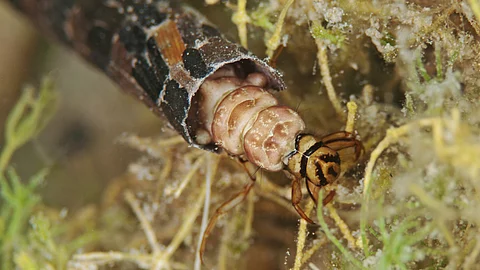

Researchers have discovered microplastics embedded in the larval casings of caddisflies, indicating that environmental contamination by plastic particles stretches back over half a century.
Caddisflies, moth-like insects of the order Trichoptera, are common across the world and inhabit freshwater ecosystems such as lakes, rivers and streams. During their aquatic larval stage, they build portable protective cases from natural materials like sand grains, small stones, bark, leaf litter and other organic debris.
But a recent study, published in the journal Science of The Total Environment, has revealed that in anthropocene, these insects have also been incorporating microplastics into their cases — an alarming sign of long-term contamination. The finding was made when scientists observed brightly coloured synthetic particles embedded in caddisfly cases.
Researchers from the Naturalis Biodiversity Center in the Netherlands analysed 549 preserved caddisfly casings from a natural history collection, looking for early instances of larvae incorporating microplastics into their structures.
One sample from 1971 stood out. It contained three distinct yellow fragments embedded in the casing. “The bright colours, straight edges and smooth material provide a first indication that those particles could be plastic,” the study noted.
Further analysis using energy-dispersive X-ray spectroscopy (EDX) confirmed that the particles contained elements such as sulphur, titanium, zinc and barium, often found in plastics and pigments.
Another sample from 1986 included multiple blue microplastic fragments. Across the full set of samples, which spanned from 1971 to 2018, many showed signs of microplastic contamination.
“This historical timeline is important to show that during the time of collection of the 1971 caddisfly, microplastic had not yet been reported for freshwater and the material had thus unintentionally found its way into the natural history collection,” the authors said.
The researchers said this is the first study to identify microplastics in freshwater invertebrates using natural history collections.
Previous studies from the 1950s have shown that some fish species ingested microfibres and plastic particles and a 1982-2006 study found microplastics in fish collected in Louisiana, United States. However, the present study predates those findings and is distinctive for focusing on insects from remote, non-urban freshwater environments such as springs and natural streams.
Despite the insights, the researchers cautioned that the limited number of casings made it difficult to assess the full extent of contamination in these habitats.
They also raised concerns about the potential impact of incorporating plastic into casings. “The inclusion of brightly coloured particles (like the yellow and blue particles reported here) may increase their visibility to visual predators like fish,” the authors of the study observed.
The use of synthetic materials could also compromise the structural integrity of the cases. Mineral grains typically offer durability, but plastics may reduce stability in fast-flowing water due to their lower density and buoyancy. This could make the larvae more vulnerable to being swept away or eaten compared to casings made from leaf litter and other organic materials.
“The prolonged interaction with the plastic once included in its casing may also result in exposure risk of harmful chemicals and toxic metals often associated with plastics,” the researchers said.
The scientists called for more research to understand the cumulative effects of these interactions on freshwater invertebrates.
“Our study highlights the importance of the preservation of long-term time series in natural history collections, and implies that microplastics have been impacting freshwater species for more than 50 years, and continue to do so on an increasing scale, as the amount of produced plastics keeps rising,” the researchers concluded.